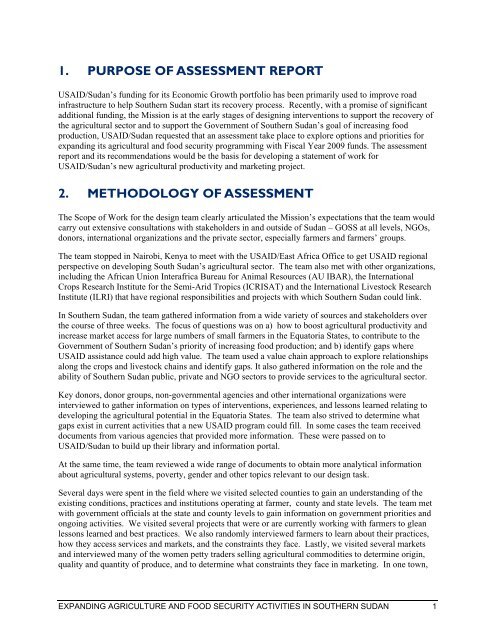expanding agriculture and food security activities in ... - part - usaid
expanding agriculture and food security activities in ... - part - usaid
expanding agriculture and food security activities in ... - part - usaid
Create successful ePaper yourself
Turn your PDF publications into a flip-book with our unique Google optimized e-Paper software.
1. PURPOSE OF ASSESSMENT REPORT<br />
USAID/Sudan’s fund<strong>in</strong>g for its Economic Growth portfolio has been primarily used to improve road<br />
<strong>in</strong>frastructure to help Southern Sudan start its recovery process. Recently, with a promise of significant<br />
additional fund<strong>in</strong>g, the Mission is at the early stages of design<strong>in</strong>g <strong>in</strong>terventions to support the recovery of<br />
the agricultural sector <strong>and</strong> to support the Government of Southern Sudan’s goal of <strong>in</strong>creas<strong>in</strong>g <strong>food</strong><br />
production, USAID/Sudan requested that an assessment take place to explore options <strong>and</strong> priorities for<br />
<strong>exp<strong>and</strong><strong>in</strong>g</strong> its agricultural <strong>and</strong> <strong>food</strong> <strong>security</strong> programm<strong>in</strong>g with Fiscal Year 2009 funds. The assessment<br />
report <strong>and</strong> its recommendations would be the basis for develop<strong>in</strong>g a statement of work for<br />
USAID/Sudan’s new agricultural productivity <strong>and</strong> market<strong>in</strong>g project.<br />
2. METHODOLOGY OF ASSESSMENT<br />
The Scope of Work for the design team clearly articulated the Mission’s expectations that the team would<br />
carry out extensive consultations with stakeholders <strong>in</strong> <strong>and</strong> outside of Sudan – GOSS at all levels, NGOs,<br />
donors, <strong>in</strong>ternational organizations <strong>and</strong> the private sector, especially farmers <strong>and</strong> farmers’ groups.<br />
The team stopped <strong>in</strong> Nairobi, Kenya to meet with the USAID/East Africa Office to get USAID regional<br />
perspective on develop<strong>in</strong>g South Sudan’s agricultural sector. The team also met with other organizations,<br />
<strong>in</strong>clud<strong>in</strong>g the African Union Interafrica Bureau for Animal Resources (AU IBAR), the International<br />
Crops Research Institute for the Semi-Arid Tropics (ICRISAT) <strong>and</strong> the International Livestock Research<br />
Institute (ILRI) that have regional responsibilities <strong>and</strong> projects with which Southern Sudan could l<strong>in</strong>k.<br />
In Southern Sudan, the team gathered <strong>in</strong>formation from a wide variety of sources <strong>and</strong> stakeholders over<br />
the course of three weeks. The focus of questions was on a) how to boost agricultural productivity <strong>and</strong><br />
<strong>in</strong>crease market access for large numbers of small farmers <strong>in</strong> the Equatoria States, to contribute to the<br />
Government of Southern Sudan’s priority of <strong>in</strong>creas<strong>in</strong>g <strong>food</strong> production; <strong>and</strong> b) identify gaps where<br />
USAID assistance could add high value. The team used a value cha<strong>in</strong> approach to explore relationships<br />
along the crops <strong>and</strong> livestock cha<strong>in</strong>s <strong>and</strong> identify gaps. It also gathered <strong>in</strong>formation on the role <strong>and</strong> the<br />
ability of Southern Sudan public, private <strong>and</strong> NGO sectors to provide services to the agricultural sector.<br />
Key donors, donor groups, non-governmental agencies <strong>and</strong> other <strong>in</strong>ternational organizations were<br />
<strong>in</strong>terviewed to gather <strong>in</strong>formation on types of <strong>in</strong>terventions, experiences, <strong>and</strong> lessons learned relat<strong>in</strong>g to<br />
develop<strong>in</strong>g the agricultural potential <strong>in</strong> the Equatoria States. The team also strived to determ<strong>in</strong>e what<br />
gaps exist <strong>in</strong> current <strong>activities</strong> that a new USAID program could fill. In some cases the team received<br />
documents from various agencies that provided more <strong>in</strong>formation. These were passed on to<br />
USAID/Sudan to build up their library <strong>and</strong> <strong>in</strong>formation portal.<br />
At the same time, the team reviewed a wide range of documents to obta<strong>in</strong> more analytical <strong>in</strong>formation<br />
about agricultural systems, poverty, gender <strong>and</strong> other topics relevant to our design task.<br />
Several days were spent <strong>in</strong> the field where we visited selected counties to ga<strong>in</strong> an underst<strong>and</strong><strong>in</strong>g of the<br />
exist<strong>in</strong>g conditions, practices <strong>and</strong> <strong>in</strong>stitutions operat<strong>in</strong>g at farmer, county <strong>and</strong> state levels. The team met<br />
with government officials at the state <strong>and</strong> county levels to ga<strong>in</strong> <strong>in</strong>formation on government priorities <strong>and</strong><br />
ongo<strong>in</strong>g <strong>activities</strong>. We visited several projects that were or are currently work<strong>in</strong>g with farmers to glean<br />
lessons learned <strong>and</strong> best practices. We also r<strong>and</strong>omly <strong>in</strong>terviewed farmers to learn about their practices,<br />
how they access services <strong>and</strong> markets, <strong>and</strong> the constra<strong>in</strong>ts they face. Lastly, we visited several markets<br />
<strong>and</strong> <strong>in</strong>terviewed many of the women petty traders sell<strong>in</strong>g agricultural commodities to determ<strong>in</strong>e orig<strong>in</strong>,<br />
quality <strong>and</strong> quantity of produce, <strong>and</strong> to determ<strong>in</strong>e what constra<strong>in</strong>ts they face <strong>in</strong> market<strong>in</strong>g. In one town,<br />
EXPANDING AGRICULTURE AND FOOD SECURITY ACTIVITIES IN SOUTHERN SUDAN 1

















